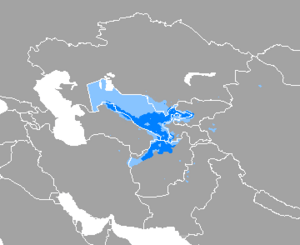Uzbek language facts for kids
Quick facts for kids Uzbek |
||||
|---|---|---|---|---|
| oʻzbekcha, oʻzbek tili, оʻзбекча, оʻзбек тили, اوزبیکچه, اوزبیک تیلی | ||||
| Native to | Uzbekistan, Afghanistan, Tajikistan, Kazakhstan, Kyrgyzstan, Turkmenistan, Russia, China | |||
| Ethnicity | Uzbeks | |||
| Native speakers | 32 million (2017)e18 | |||
| Language family | ||||
| Early forms: |
Middle Turkic
|
|||
| Writing system | Latin, Cyrillic and Arabic (used in Afghanistan and China), Uzbek Braille (Uzbek alphabets) |
|||
| Official status | ||||
| Official language in | ||||
| Recognised minority language in | ||||
| Regulated by | Tashkent State University of Uzbek language and literature | |||
| Linguasphere | 44-AAB-da, db | |||

Dark blue = majority; light blue = minority
|
||||
|
||||
Uzbek is a fascinating language spoken by millions of people. It's a Turkic language, which means it's related to languages like Turkish, Azerbaijani, and Kazakh. In Uzbekistan, Uzbek is the official language. About 40 million people speak Uzbek as their first language. Most of these speakers are Uzbeks living in Uzbekistan and other parts of Central Asia.
Contents
Where Is Uzbek Spoken?
Uzbek is mainly spoken in Uzbekistan, where it is the national language. But it's also an important language in other countries. You'll find Uzbek speakers in Afghanistan, where it's one of the official languages. Many people also speak Uzbek in neighboring countries like Tajikistan, Kazakhstan, Kyrgyzstan, and Turkmenistan. There are also Uzbek communities in Russia and China.
Uzbek Language Family
Uzbek belongs to the southeastern branch of the Turkic language family. This branch is sometimes called the Karluk or Uyghur family. This means Uzbek shares roots with languages like Uyghur, which is spoken in China. All Turkic languages come from a common ancestor language.
Writing Uzbek: Different Alphabets
One interesting thing about Uzbek is that it has been written using different alphabets over time.
Latin Alphabet
Today, in Uzbekistan, Uzbek is mostly written using the Latin script. This is similar to the alphabet used for English. It was adopted to make it easier for people to learn and use the language.
Cyrillic Alphabet
For a long time, especially during the Soviet era, Uzbek was written using the Cyrillic script. You might recognize this alphabet from Russian. Some older books and documents are still in Cyrillic.
Arabic Alphabet
In places like Afghanistan and China, Uzbek is often written using the Arabic script. This is the traditional way Uzbek was written for centuries. It shows the historical and cultural connections of the region. There's even a special Uzbek Braille system for people who are visually impaired.
A Brief History of Uzbek
The Uzbek language has a rich history. It developed from older Turkic languages spoken in Central Asia.
Old Turkic Roots
The language has roots in Middle Turkic, which was spoken many centuries ago. Over time, different dialects and influences shaped what we now know as Uzbek.
Chagatai Language Influence
A very important ancestor of modern Uzbek is the Chagatai language. This was a literary language used in Central Asia from the 15th to the early 20th centuries. Famous poets and writers, like Alisher Navoi, wrote in Chagatai. Modern Uzbek developed directly from this rich literary tradition.
Why Learn Uzbek?
Learning Uzbek can be a great way to explore the culture of Central Asia.
Connecting with Culture
Uzbekistan is known for its ancient cities, like Samarkand and Bukhara, which were important stops on the Silk Road. Knowing Uzbek can help you connect with local people and understand their traditions, music, and stories.
Travel and Exploration
If you ever travel to Uzbekistan or other Central Asian countries, knowing some Uzbek phrases will make your trip much more enjoyable. It helps you navigate, order food, and make new friends.
Images for kids
See also
 In Spanish: Idioma uzbeko para niños
In Spanish: Idioma uzbeko para niños


